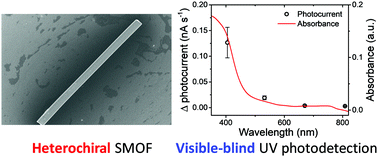Micro-/nano-sized multifunctional heterochiral metal–organic frameworks for high-performance visible–blind UV photodetectors†
Abstract
Chiral supramolecular metal–organic frameworks (SMOFs), i.e., AlaNDI-Ca micro-/nanocrystals have been synthesized via solvothermal reaction using alanine-based naphthalene diimide (NDI) ligands and calcium nitrate. Interestingly, chiral self-discrimination is observed upon mixing two enantiomeric ligands with calcium nitrate due to the thermodynamic preference of heterochiral SMOFs over homochiral analogs. Upon irradiation with UV light, the conductivity of SMOFs micro-/nanocrystals significantly increases and their color changes from yellow to dark brown, due to the electron-transfer-related chemical processes inside the SMOF and/or photo-induced radical formation in NDI ligands, while they are not responsive to visible light. Heterochiral AlaNDI-Ca micro-/nanocrystals with a large band gap exhibit excellent photoswitching properties, due to the reversible generation and depletion of radicals upon exposure to UV light or in the dark, respectively. To our knowledge, photodetecting MOFs for optoelectronics are extremely rare, and herein we have firstly quantitatively characterized single crystalline SMOF photodiodes with redox NDI ligands with regard to their visible-blind UV photodetecting properties with high photoresponsivity and detectivity, which exhibit superior performances in comparison with precedent MOF-based photodetectors. These findings pave the way for applications of multifunctional micro-/nanoscaled MOFs in next-generation optoelectronics.



 Please wait while we load your content...
Please wait while we load your content...